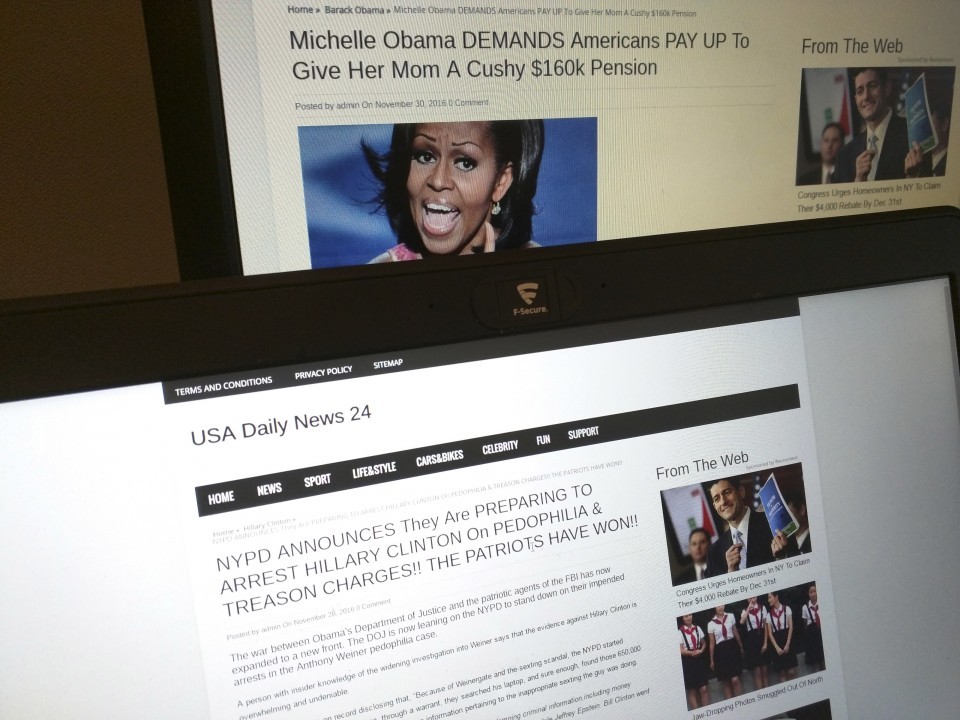Flemming Rose is a WorldPost contributor and a senior fellow at the Cato Institute. Jacob Mchangama is director of the Copenhagen-based think tank Justitia.
Copenhagen, Denmark — In the 4th century B.C., Athenian orator Demosthenes remarked that the difference between Athenian democracy and Spartan oligarchy was that in Athens, a person could praise the Spartan Constitution and criticize the Athenian one, whereas in Sparta, praising any other constitution was forbidden. This litmus test is still relevant for democracies more than 2,000 years later. But it is equally crucial for a genuine liberal democracy that no one, and particularly no official institution, gets to determine the truth in matters of politics and public debate.
Nevertheless, Italy’s antitrust chief Giovanni Pitruzzella feels so overwhelmed by the amount of information on the internet that he has called for government regulation to fight fake news. Pitruzzella builds his case by contrasting the First Amendment with the European Convention on Human Rights, which he argues provides no constitutional protection of “fake news.” This is due to an interpretation of the limits of protected speech that says that the distribution of “fake news,” in Pitruzzella’s words, violates Europeans’ “right to be pluralistically informed.”
We agree with Pitruzzella that the deliberate dissemination of false information is a menace to any society. However, his strategy to fight false statements may be even worse than the lies themselves. He wants the government to get involved in the process of verifying information and removing what it defines as “fake news.” Media companies that do not comply should be fined, he argues.
This is problematic for several reasons. First, there is a huge amount of empirical data from different countries throughout history that make it clear that even democratic governments tend to use this kind of power to silence opponents and shut down speech they don’t like. During the French Revolution, for example, policing the truth resulted in the execution of those who were accused of disseminating false news, which included anyone critical of those behind the Reign of Terror. In 1798, the U.S. Congress passed the Sedition Act in order to punish false statements about the government made with malicious intent. It was used to suppress opinion with which the Federalist administration of President John Adams disagreed. This is one of the reasons why prosecution for lies about the government are outlawed in the U.S. and why this kind of speech is protected by the First Amendment.
Interestingly, President Donald Trump has suggested that libel laws be changed to cover what he categorizes as “fake news” about himself by mainstream media outlets, such as The New York Times. Apparently, Trump has some support for this unconstitutional idea. Asked in an Economist/YouGov poll whether courts should be able to “shut down” media outlets for “publishing or broadcasting stories that are biased or inaccurate,” 45 percent of Republicans were in favor, and 55 percent of Republicans favored fining such “biased or inaccurate” media outlets. But, the First Amendment stands in the way of Trump restricting journalism that is critical of his person and policies.
There is no reason to think Europeans would be more responsible if given the possibility of criminalizing fake news. Already, some European countries, including Poland and Hungary, have moved against independent and critical media. In some instances, it would be impossible for a publication to defend itself effectively against fake news accusations. Imagine that the Guardian newspaper published a story based on anonymous sources about deep divisions over Brexit within the British government, and the British government subsequently denied the story and accused the Guardian of publishing fake news to undermine the government and derail the Brexit process. How would the Guardian prove that its story was true without being forced to disclose its sources and thus undermine an essential element of critical journalism?
In non-democratic societies, the ban on disseminating false information is a powerful instrument to help persecute religious and ethnic minorities and to silence political dissent. This goes for the Communist countries behind the Iron Curtain during the Cold War as well as for present-day authoritarian regimes, such as Egypt, Russia, China and Turkey. In effect, laws against fake news stories relating to political events — rather than defamation aimed at individuals — would require that democracies empower police and ultimately judges to become the arbiters of truth. The threat of punishment would intimidate people and deter even true statements and opinions.
It is true that European human rights standards do not protect categories such as hate speech, Holocaust denial, or the advancement of Nazi or jihadist ideology. But the European Court of Human Rights is yet to hand down its first decision on false news. An in Salov v. Ukraine, the European Court held that:
“Article 10 of the Convention as such does not prohibit discussion or dissemination of information received even if it is strongly suspected that this information might not be truthful. To suggest otherwise would deprive persons of the right to express their views and opinions about statements made in the mass media and would thus place an unreasonable restriction on the freedom of expression.”
There is a very strong case for arguing that the criminalization of fake news runs afoul of freedom of expression in international and other regional human rights conventions. In an advisory opinion, the Inter-American Court of Human Rights stated: “A system that controls the right of expression in the name of a supposed guarantee of the correctness and truthfulness of the information that society receives can be the source of great abuse and, ultimately, violates the right to information that this same society has.”
In Cameroon, the United Nations Human Rights Committee stated in a 1999 ruling that “the prosecution and punishment of journalists for the crime of publication of false news merely on the ground, without more, that the news was false, [is a] clear violation of Article 19 of the Covenant.”
Significantly, on March 3, a joint declaration on the matter was issued from all corners of the world, including by the U.N., the Organization for Security and Cooperation in Europe, the Organization of American States, and the African Commission on Human and Peoples’ Rights. The declaration states that “general prohibitions on the dissemination of information based on vague and ambiguous ideas, including ‘false news’ or ‘non-objective information,’ are incompatible with international standards for restrictions on freedom of expression … and should be abolished.”
Pitruzzella indicates that the government should regulate news and speech so that we avoid “information overload” and “group polarization.” A better way to pursue this would be through education, awareness-building and training so we learn the importance of being exposed to other points of views and acquire the necessary tools to find out for ourselves whether the information presented to us is false or not. Citizens in the digital age can do a lot to avoid algorithm-driven echo chambers, including interacting with social media accounts of people with whom we vehemently disagree or doing additional research on “news” stories that fit our own biases.
While it may still only be a minority that chooses such a critical approach to news consumption, we should allow a new culture befitting the digital age to manifest itself, though the process should be helped through education and critical reflection. This process is already underway — numerous universities, think tanks and nongovernmental organizations are grappling with the issue of fake news and echo chambers, while new initiatives aimed at combating these phenomena are being tested as we speak.
Yes, our digital era and the explosion of speech and communication on social media are unique. But the introduction of the printing press in the 15th century and its impact on the world in the ensuing centuries may serve as an instructive analogy from which Pitruzzella may take a lesson or two. In the 16th and 17th century, access to the press triggered waves of fake news and dissemination of wild conspiracy theories about witches and millenarian crazes. Religious fanaticism was printed side-by-side with scientific discoveries. During the first century after Gutenberg, print did as much to spread lies and false information as enlightened truth.
Back then, the religious and political authorities panicked and set up draconian regimes of censorship, like the Catholic Church’s “Index Librorum Prohibitorum” on prohibited books. It had disastrous consequences. Those who did not utilize the printing press lagged behind the early adopters. In retrospect, it turned out to be far more important to explore the upside of the new technology than to protect against the potential downside. Facing the ups and downs of the digital technology in the 21st century, we must heed this lesson.
This was produced by The WorldPost, a partnership of the Berggruen Institute and The Washington Post.




